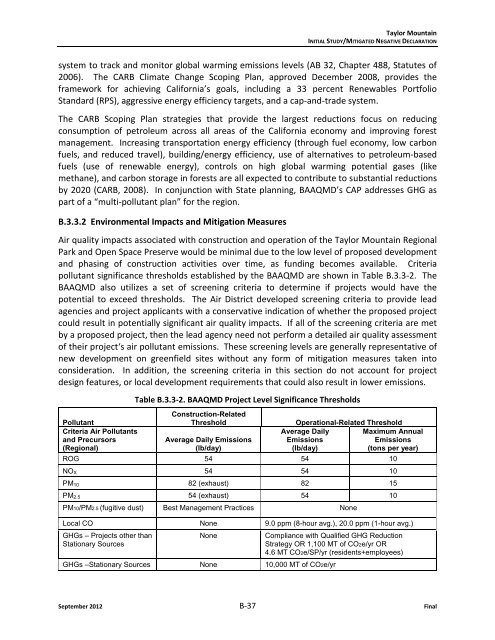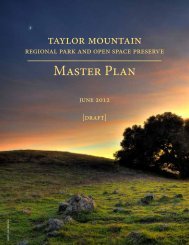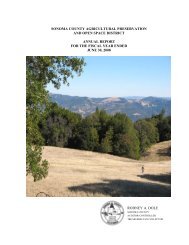Taylor MountainINITIAL STUDY/MITIGATED NEGATIVE DECLARATIONcorresponding NAAQS. State <strong>and</strong> national ambient air quality st<strong>and</strong>ards have been establishedfor the following pollutants: ozone, carbon monoxide, nitrogen dioxide, sulfur dioxide, fineparticulate matter (PM 10 ) <strong>and</strong> lead. The State has also established ambient air qualityst<strong>and</strong>ards for sulfates, hydrogen sulfide, vinyl chloride <strong>and</strong> visibility reducing particles.Attainment Status. The U.S.Table B.3.3-1. Attainment Status of San Francisco Bay AreaEPA, CARB, <strong>and</strong> the local airBay Area Air Basindistrict (BAAQMD) classify anPollutantsFederal Classificationarea as attainment, unclassified,Ozone Nonattainment Nonattainmentor nonattainment. ThePM10 Unclassified Nonattainmentclassification depends onPM2.5 Nonattainment Nonattainment*whether the monitored ambientair quality data show compliance,insufficient data available, orCONO2AttainmentAttainmentAttainmentAttainment**non-compliance with the SO2 Attainment Attainmentambient air quality st<strong>and</strong>ards, *For 24-hour st<strong>and</strong>ard; attainment for annual st<strong>and</strong>ardrespectively. Table B.3.3-1 **For annual st<strong>and</strong>ard; Unclassified for 1-hour st<strong>and</strong>ardSource: BAAQMD, 2011summarizes attainment status forthe criteria pollutants in the project region with both the federal <strong>and</strong> state st<strong>and</strong>ards.Bay Area Air BasinState ClassificationAir Quality Plans. The federal Clean Air Act requires non-attainment <strong>and</strong> maintenance areas toprepare air quality plans that include strategies for attaining <strong>and</strong> maintaining the federalst<strong>and</strong>ards. The California Clean Air Act also requires plans for state-level nonattainment areasfor any pollutant except particulate matter.In September 2010, the BAAQMD adopted the 2010 Clean Air Plan (CAP) <strong>and</strong> certified the FinalProgram Environmental Impact Report on the CAP, reaffirming <strong>and</strong> exp<strong>and</strong>ing thetransportation management policies of the 2005 Ozone Strategy. In June 2010, the BAAQMDadopted updated CEQA Guidelines <strong>and</strong> thresholds of significance. 2Greenhouse Gases. The California Global Warming Solutions Act of 2006, Assembly Bill 32 (AB32) requires that California’s greenhouse gas (GHG) emissions be reduced to 1990 levels by2020. The reduction is to be accomplished through an enforceable statewide cap on globalwarming emissions. AB 32 directs the CARB to develop regulations <strong>and</strong> a m<strong>and</strong>atory reporting2On March 5, 2012, the Alameda <strong>County</strong> Superior Court overturned on CEQA grounds BAAQMD’s adoption of itsnew CEQA Guidelines <strong>and</strong> thresholds (Alameda Superior Court Case No. RG10-548693). Although the Court’sorder prohibits BAAQMD from further dissemination of the thresholds as a BAAQMD-approved set of airquality thresholds, it does not prohibit a local lead agency from relying on these thresholds for purposes ofevaluating a project’s air quality emissions. The claims made in the case concerned the environmental impactsof adopting the thresholds, that is, how the thresholds would indirectly affect l<strong>and</strong> use developmentpatterns. Those issues are not relevant to the scientific soundness of the BAAQMD’s analysis of what levels ofpollutants should be deemed significant, or the threshold to use in assessing any health risk impact a projectwill have on the existing environment. Moreover, the thresholds will not cause any indirect impact in terms ofl<strong>and</strong> use development patterns insofar as this project is concerned, because the proposal to develop <strong>and</strong>implement the Taylor Mountain Regional Park <strong>and</strong> Preserve was not influenced by the BAAQMDguidelines. Accordingly, the analysis herein uses the updated thresholds <strong>and</strong> methodologies from BAAQMD’sCEQA Air Quality Guidelines to determine the potential impacts of the project on the existing environment.Final B-36 September 2012
Taylor MountainINITIAL STUDY/MITIGATED NEGATIVE DECLARATIONsystem to track <strong>and</strong> monitor global warming emissions levels (AB 32, Chapter 488, Statutes of2006). The CARB Climate Change Scoping Plan, approved December 2008, provides theframework for achieving California’s goals, including a 33 percent Renewables PortfolioSt<strong>and</strong>ard (RPS), aggressive energy efficiency targets, <strong>and</strong> a cap-<strong>and</strong>-trade system.The CARB Scoping Plan strategies that provide the largest reductions focus on reducingconsumption of petroleum across all areas of the California economy <strong>and</strong> improving forestmanagement. Increasing transportation energy efficiency (through fuel economy, low carbonfuels, <strong>and</strong> reduced travel), building/energy efficiency, use of alternatives to petroleum-basedfuels (use of renewable energy), controls on high global warming potential gases (likemethane), <strong>and</strong> carbon storage in forests are all expected to contribute to substantial reductionsby 2020 (CARB, 2008). In conjunction with State planning, BAAQMD’s CAP addresses GHG aspart of a “multi-pollutant plan” for the region.B.3.3.2 Environmental Impacts <strong>and</strong> Mitigation MeasuresAir quality impacts associated with construction <strong>and</strong> operation of the Taylor Mountain RegionalPark <strong>and</strong> Open Space Preserve would be minimal due to the low level of proposed development<strong>and</strong> phasing of construction activities over time, as funding becomes available. Criteriapollutant significance thresholds established by the BAAQMD are shown in Table B.3.3-2. TheBAAQMD also utilizes a set of screening criteria to determine if projects would have thepotential to exceed thresholds. The Air District developed screening criteria to provide leadagencies <strong>and</strong> project applicants with a conservative indication of whether the proposed projectcould result in potentially significant air quality impacts. If all of the screening criteria are metby a proposed project, then the lead agency need not perform a detailed air quality assessmentof their project‘s air pollutant emissions. These screening levels are generally representative ofnew development on greenfield sites without any form of mitigation measures taken intoconsideration. In addition, the screening criteria in this section do not account for projectdesign features, or local development requirements that could also result in lower emissions.PollutantCriteria Air Pollutants<strong>and</strong> Precursors(Regional)Table B.3.3-2. BAAQMD Project Level Significance ThresholdsConstruction-RelatedThresholdAverage Daily Emissions(lb/day)Operational-Related ThresholdAverage DailyEmissions(lb/day)Maximum AnnualEmissions(tons per year)ROG 54 54 10NO X 54 54 10PM 10 82 (exhaust) 82 15PM 2.5 54 (exhaust) 54 10PM10/PM2.5 (fugitive dust) Best Management Practices NoneLocal CO None 9.0 ppm (8-hour avg.), 20.0 ppm (1-hour avg.)GHGs – Projects other thanStationary SourcesNoneCompliance with Qualified GHG ReductionStrategy OR 1,100 MT of CO2e/yr OR4.6 MT CO2e/SP/yr (residents+employees)GHGs –Stationary Sources None 10,000 MT of CO2e/yrSeptember 2012 B-37 Final







